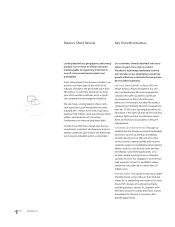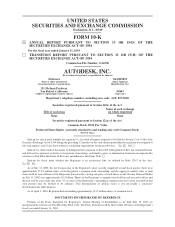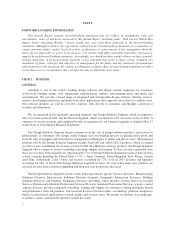Autodesk 2003 Annual Report Download - page 18
Download and view the complete annual report
Please find page 18 of the 2003 Autodesk annual report below. You can navigate through the pages in the report by either clicking on the pages listed below, or by using the keyword search tool below to find specific information within the annual report.INTELLECTUAL PROPERTY AND LICENSES
We protect our intellectual property through a combination of patents, copyright and trademark laws, trade
secrets, confidentiality procedures and contractual provisions. Nonetheless, our intellectual property rights may
not be successfully asserted in the future or may be invalidated, circumvented or challenged. In addition, the laws
of various foreign countries where our products are distributed do not protect our intellectual property rights to
the same extent as U.S. laws. Our inability to protect our proprietary information could harm our business.
From time to time, we receive claims alleging infringement of a third party’s intellectual property rights,
including patents. Litigation often becomes more likely in times of economic downturn. Disputes involving our
intellectual property rights or those of another party have in the past and may in the future lead to, among other
things, costly litigation or product shipment delays, which could harm our business.
We retain ownership of software we develop. All software is licensed to users and provided in object code
pursuant to either shrink-wrap, embedded or on-line licenses, or executed license agreements. These agreements
contain restrictions on duplication, disclosure and transfer.
We believe that because of the limitations of laws protecting our intellectual property and the rapid, ongoing
technological changes in both the computer hardware and software industries, we must rely principally upon
software engineering and marketing skills to maintain and enhance our competitive market position.
While we have recovered some revenues resulting from the unauthorized use of our software products, we
are unable to measure the extent to which piracy of our software products exists. We believe, however, that
software piracy is and can be expected to be a persistent problem.
PRODUCTION AND SUPPLIERS
Production of our Design Solutions Segment software products involves duplication of the software media
and the printing of user manuals. The purchase of media and the transfer of the software programs onto media for
distribution to customers are performed by us and by licensed subcontractors. Media for our products include
CD-ROMs and diskettes, which are available from multiple sources. User manuals for our products and
packaging materials are produced to our specifications by outside sources. Production is generally performed in
leased facilities operated by us. Some product assembly is also performed by independent third-party contractors.
To date, we have not experienced any material difficulties or delays in the production of our software and
documentation.
In addition, the Discreet segment has historically relied on third-party vendors for the supply of hardware
components used in its systems. Many of the Discreet’s software products currently run on workstations
manufactured by Silicon Graphics, Inc. (“SGI”). There are significant risks associated with this reliance on SGI
and Discreet may be impacted by unforeseen difficulties associated with adapting their products to future SGI
products and the timing of the development and release of SGI products.
EMPLOYEES
As of January 31, 2003, we had 3,498 full-time equivalent employees. None of our employees in the U.S.
are represented by a labor union; however, in certain foreign countries, our employees are represented by worker
councils. We have never experienced any work stoppages.
Our continued growth and future success is highly dependent on the ability to attract, retain and motivate
highly skilled employees.
9
























